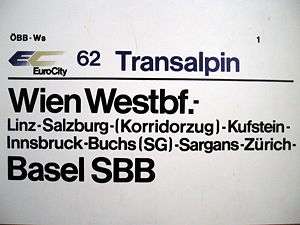Privileged transit traffic

Destination sign on a Transalpin EuroCity train
The privileged transit traffic or corridor traffic is traffic of one country across the territory of another country without usual customs and passport checks. The corresponding line of communication (usually a railway) is called the (privileged) traffic corridor and a train used in this kind of transit is called a corridor train (German: Korridorzug, Italian: Treno-corridoio). The reason for such arrangements is usually border changes or border creation which cut through an existing transport corridor.
Examples
Estonia
- The road from Värska to Ulitina in Estonia, traditionally the only road to the Ulitina area, goes through Russian territory for one kilometre (0.6 mi) of its length, an area called Saatse Boot. This road has no border control, but there is no connection to any other road in Russia. It is not permitted to stop or walk along the road. This area is a part of Russia but is also a de facto part of the Schengen area. This arrangement started in 1991 and remains as of 2016.
Finland
- Finland leases the 19.6 km-long Russian part of the Saimaa Canal from Russia and is granted extraterritoriality rights. Russian visas are not required for just passing through the canal, but a passport is needed and it is checked at the border.
Poland
- A 1931 agreement between Poland and Romania for railway traffic between parts of Poland across Romania, between Zaleszczyki and Jasienów Polny (now Yaseniv-Pil'nyi). Since 1945, both places have been in Ukraine.[1]
- During the years between the world wars German trains could travel to and from East Prussia across the Polish Corridor with legally sealed doors, thereby relieving the passengers of obtaining Polish visas.
Russia
- Railway connection between mainland Russia and its Kaliningrad Oblast exclave across Belarus and Lithuania. This is not privileged since normal passport and visa rules apply.
Germany
- A historical case of privileged transit was the arrival of Vladimir Lenin in a "sealed train car" through Germany from Switzerland to Russia (through Sweden as a normal passenger) in April 1917, amid World War I and Russian revolutionary activity.[2]
- Communication between East Prussia and mainland Germany across the Polish Corridor during the interwar period.
- Zittau–Görlitz (by train) from 1948, through Poland. This is still in operation as of 2014, but since 2007 the Schengen area removed all passport checks at the German–Polish border.
- In the cold war era, 1961-1990, Berlin U-Bahn and Berlin S-Bahn trains passed along sealed tunnels through East Berlin, without any check or any stop. The sealed stations were called ghost stations.
- Büsingen am Hochrhein is part of Germany but surrounded by Switzerland and counting as Switzerland for customs purposes. There were no border controls around Büsingen even when there were controls along the Swiss-German border until 2008. Vehicles registered in Büsingen had the privilege of relaxed or often no checks at the nearest border and customs control.
Austria
- Trains between Salzburg and Kufstein operated (via Germany) as privileged transit until 1997 when the Schengen area removed passport checks at this border. Border checks were reintroduced for them in 2015-2016 because of the European migrant crisis.[3]
- After World War II a 'corridor-train' service was established between Lienz and Innsbruck using the Puster Valley railway (via Italy); this services lost importance after the Schengen Agreement, and was discontinued after 2013.
- During the Cold War trains with locked doors were allowed to go from northern to southern Burgenland by traversing a small part of western Hungary.
Czech Republic
- After World War II, in 1945, a 2.7 km part of the railway line Varnsdorf (CS) – Zittau (DE) – Liberec (CS) through Porajów became part of Poland and international traffic was stopped. In 1951, the Czechoslovak Railways restored Varnsdorf – Liberec connection based on an agreement with GDR and Poland; ČSD trains had no stop at Polish and German area. In 1964, a new treatment was signed. Since 1972, GDR and Czechoslovakia restored also standard international transport at this line. After broadening of the Schengen area, Varnsdorf – Liberec trains stop also at German area, but traffic through the Polish section is still based on the transit agreement. The Polish side gets a charge from the Czech side but neglects the Polish section and refuses proposals of Czech or German participation on the maintenance.[4]
Air traffic
Air traffic has in general a number of privileged transit traffic rights, making it suitable to reach enclaves or isolated countries.
- First freedom of the air: The right to fly over another country.
- Second freedom of the air: The right to make technical stops (such as refuelling) in another country without customs and passport check.
- Airside transit: The right for passengers to change aircraft at airports, without going through passport control.
References
- ↑ Poland and Romania: Convention of the Freedom of Transit by Rail from One Part of Polish Territory to Another (retrieved July 4, 2014)
- ↑ "Lenin returns to Russia from exile", History Channel
- ↑ ÖBB Fernverkehrszüge können wieder über Salzburg nach München und Innsbruck fahren
- ↑ Hrozí zastavení vlaků do Německa. Poláci se nemají k opravě trati, iDnes.cz, 15. 5. 2015
This article is issued from
Wikipedia.
The text is licensed under Creative Commons - Attribution - Sharealike.
Additional terms may apply for the media files.